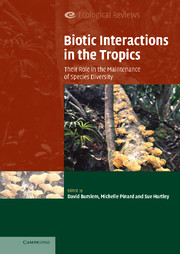Book contents
- Frontmatter
- Contents
- List of contributors
- Preface
- PART I Plant–plant interactions
- 1 Plant–plant interactions in tropical forests
- 2 Resource capture and use by tropical forest tree seedlings and their consequences for competition
- 3 Role of life-history trade-offs in the equalization and differentiation of tropical tree species
- 4 Neighbourhood effects on sapling growth and survival in a neotropical forest and the ecological-equivalence hypothesis
- 5 Ecological drift in niche-structured communities: neutral pattern does not imply neutral process
- PART II Plant–microbe interactions
- PART III Plant–animal interactions
- PART IV Biotic interactions in human-dominated landscapes
- Index
- References
5 - Ecological drift in niche-structured communities: neutral pattern does not imply neutral process
Published online by Cambridge University Press: 25 August 2009
- Frontmatter
- Contents
- List of contributors
- Preface
- PART I Plant–plant interactions
- 1 Plant–plant interactions in tropical forests
- 2 Resource capture and use by tropical forest tree seedlings and their consequences for competition
- 3 Role of life-history trade-offs in the equalization and differentiation of tropical tree species
- 4 Neighbourhood effects on sapling growth and survival in a neotropical forest and the ecological-equivalence hypothesis
- 5 Ecological drift in niche-structured communities: neutral pattern does not imply neutral process
- PART II Plant–microbe interactions
- PART III Plant–animal interactions
- PART IV Biotic interactions in human-dominated landscapes
- Index
- References
Summary
Introduction
The neutral vs. structure debate
We can define a neutral community as one in which all species, and so all individuals, are equivalent, in the sense that they are interchangeable at all times and under all conditions. In contrast, we can define a structured community as one in which species are not equivalent, and species-specific differences affect the population dynamics, and therefore the behaviour, of the community.
This distinction is an important one, because in a neutral community the biodiversity, as measured by species richness and abundance patterns, has nothing to do with the biogeochemical functioning of the community (e.g. carbon fixation and nutrient-cycling). In fact, in a truly neutral community one could eliminate all but one species without affecting the biogeochemical functioning of the community at all.
In contrast, much of the species-specific variation in biological traits observed in reality (see below) has direct relevance for the functioning of the community. For example, the short-term carbon uptake of a forest depends on the growth rates of the individual trees, and the long-term carbon storage depends on adult life-span and wood density, and there is wide species-specific variation in these traits. In niche-structured communities, the biodiversity and functioning are intimately linked, and some combination of at least some species is required to maintain the functioning of the community.
- Type
- Chapter
- Information
- Biotic Interactions in the TropicsTheir Role in the Maintenance of Species Diversity, pp. 107 - 138Publisher: Cambridge University PressPrint publication year: 2005
References
- 76
- Cited by



